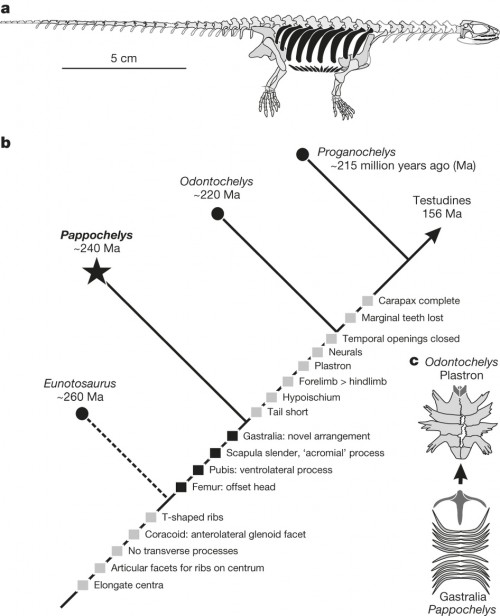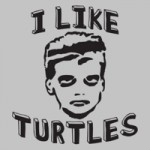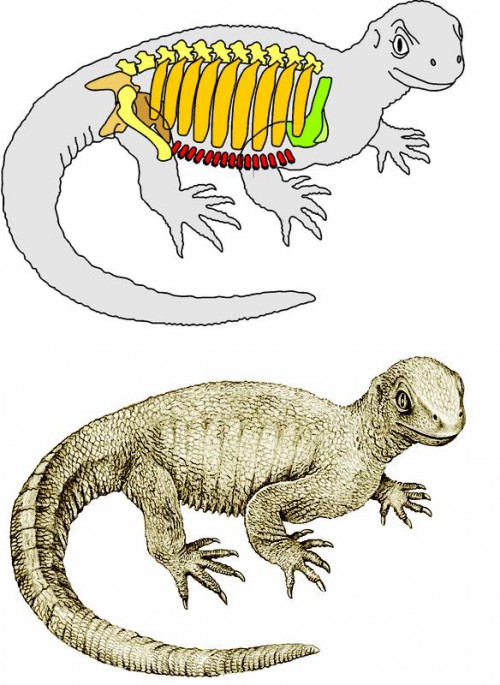Turtles are nifty animals, with a remarkable adaptation: they’ve taken their ribs and shifted them outside their appendicular skeleton, flattened and expanded them, and turned them into a shell. It’s a clever twist, and it doesn’t require any magic — just a shift in timing during development, with a little extra signaling. The molecular biology and development explain mechanistically how it happened, and we also have fossils of some of the in-between states.
Odontochelys, a 220 million year old fossil, for instance, is a good example of a turtle ancestor that’s got some of the bits but not all. It has a well developed plastron, the belly armor of a turtle, but it doesn’t have a shell — it has broadened ribs that form a kind of flexible bony plate under the skin.
And now we have even older ancestor, from 240 million years ago, called Pappochelys. It lacks the plastron, too, instead having an array of ventral ‘ribs’, called gastralia. What caught the attention of the researchers was the true ribs. They also are flattened and broadened — they look like curvy cricket bats.

a, Trunk rib in dorsal view (SMNS 92067); b, trunk rib in anterior view (SMNS 92068); c, d, trunk ribs in ventral view (c, SMNS 92063; d, SMNS 91360)
It looks distinctly lizardy in the reconstructions, but when you look at the bones you get the impression of a bony box, a kind of underlying lorica segmentata.
I also really like this diagram that illustrates the gradual acquisition of turtle-like features over the long history of this clade.

a, Restoration of the skeleton of Pappochelys in lateral view (as yet unknown elements in white; preserved bones in grey; trunk ribs and gastralia highlighted in black); b, successive appearance of key features of the turtle body plan; c, plastron of Odontochelys and reconstructed ventral bones of the shoulder girdle and gastralia set in Pappochelys (elements of the shoulder girdle and their homologues are indicated in a darker shade of grey).
Take a look at that skull: it’s got two small openings in the back. It’s a diapsid!
Schoch RR, Sues HD (2015) A Middle Triassic stem-turtle and the evolution of the turtle body plan. Nature doi: 10.1038/nature14472. [Epub ahead of print]




I saw an article about this nifty critter yesterday. Very cool!
But where on that diagram would Gamera and Mitch McConnell fit?
Gamera: Somewhere way up in space. McConnell: way, way, way off to the right.
Interestingly, there’s a therapsid with quite similar ribs: Thrinaxodon. No idea if it was using them for that purpose.
And wait, Eunotosaurus is the outgroup? It isn’t even an archosauromorph. It may not even be a diapsid.
My comparative vert anatomy prof described the role of gastralia in crocs as raising the abdomen to enable faster locomotion when they move their limbs under their bodies and haul ass. Would the role have been the same in the ancestors of turtles?
@4 marinerachel
My theory which is mine is that the plastron developed first, not for protection, but for locomotion.
Some semiaquatic environments are neither ground nor water but some kind of mushy in between that you can’t walk on or swim through. If you had a thing like a toboggan on your belly you could just slide along pushing with your feet.
I’ve been trying to get my granddaughter to do a science fair experiment where bean bag prototurtles; some with and some without plastrons are dragged across different surfaces to see which uses the least energy. She won’t do it because she has no interest in science. Also she goes to Catholic School so there’s no science fair.
I love it when researchers fill in the gaps in the fossil record. Smaller gaps makes it harder for the crebots to pretend to plausibly deny small changes are occurring with time, leading to speciation given sufficient time.
kevinalexander @#5
So that would be the Aquatic Lizard hypothesis of development?
;-)
(Aquatic ape hypothesis)
I wondered for a while whether turtles are diapsids that secondarily lost their temporal fenestra rather than themselves being anapsids. Aron Ra is going to have to update some of his videos.
Does this mean that the Anapsida is officially extinct, or is it the whole clade polyphyletic and in need of revision?
Seeing this I am somewhat surprised that turtles haven’t ever been on the creationists’ go-to list of Things That Can’t Possibly Have Evolved. Because how do you get from ribs on the inside to a carapace? Well I guess we figured that out. Though come to think of it I wouldn’t be surprised if creationists start mentioning turtles now, which would be awesomely stupid.
Also, A Transitional Turtle is my Flo and Eddie cover band.
If you follow the very first link in the post, you’ll discover that article was prompted by a creationist asking how turtle shells evolved. So, yeah, it’s one of those things I’ve been asked about multiple times.
#8 Callinectes: Anapsida has been officially extinct (that is, we know that turtles are diapsids) for several years now. The molecular data have been pretty conclusive on that point, and on the related point that turtles are the living sister group of birds and crocodiles. See this, for example.
It’s just that some paleontologists aren’t all that interested in molecular data.
The description of those ribs reminded me of the Thor’s Hero Shrew, which has evolved itself an unbreakable backbone, to wit:
http://blogs.scientificamerican.com/running-ponies/new-species-thors-hero-shrew-will-back-itself-in-any-feat-of-strength/
Maybe in a few milennia their descendants will have something like turtle shells too!
I keep a 55g aquarium and one of the things I would love to add is a turtle.
Sadly, it would probably eat everything else I own (which is all in delicate balance). I should just abandon the dream.
“A Transitional Turtle”…
Thanks for the plot-bunny. I now need to go write a TMNT fanfic where one of the titular Turtles is trans*.
Grandpa! (with a few “greats”).
moarscienceplz @7
: ) Yes except that the apes left the aquatic to return to land while the chelys mostly didn’t.
gog @13
I kept a couple of red eared sliders in a tank for years and, yes, they will chomp on anything that you put in with them, including each other. I found that out–or rather a couple of expensive and exotic frogs found that out the hard way.
Johnny Vector at 9
Flo and Eddie. I loved them.